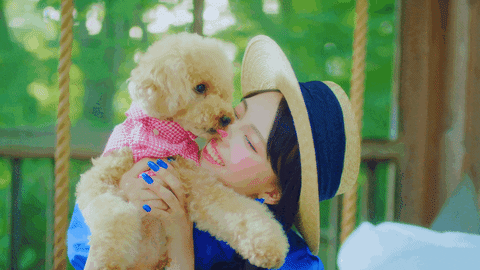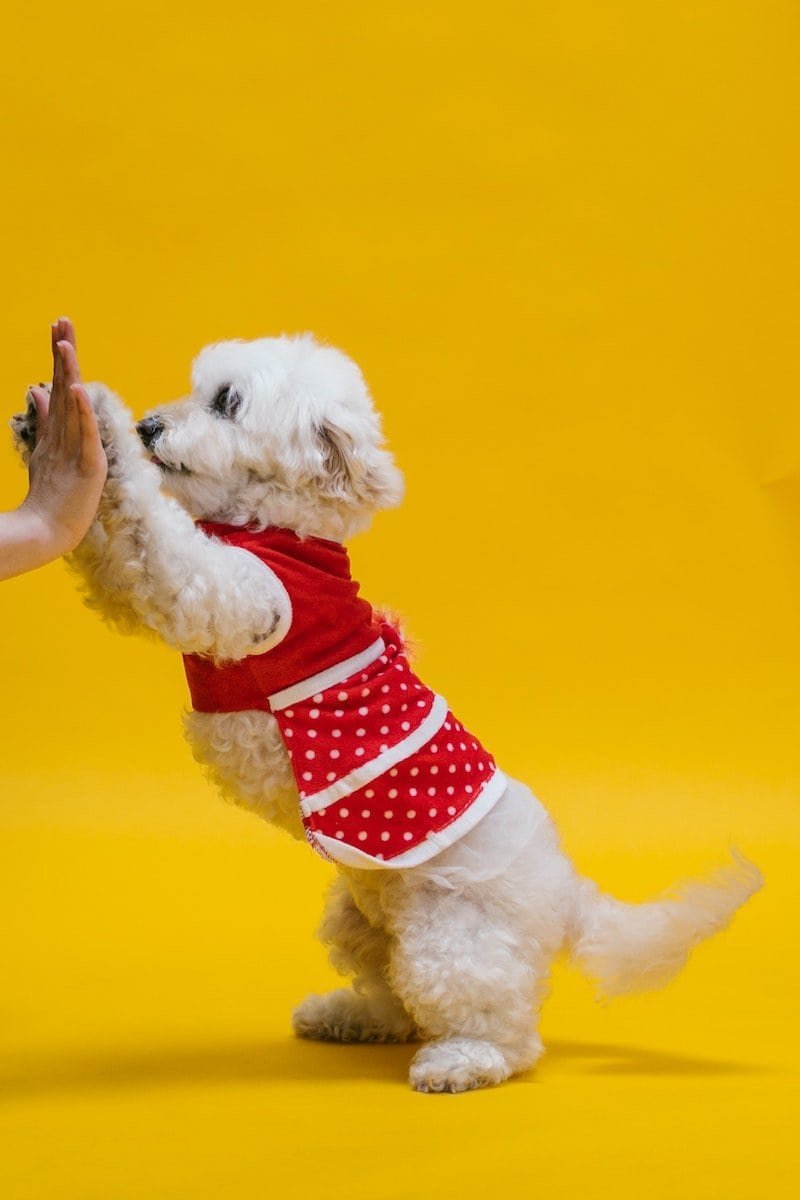Positive reinforcement training is a humane and effective way to train dogs, including poodles, to behave appropriately. It involves rewarding desirable behavior with treats, praise, or affection, which helps to build trust between you and your pet. Positive reinforcement training is a powerful tool that can be used to shape or change your dog’s behavior, making it an essential aspect of dog training.
Understanding positive reinforcement is key to successful dog training. Positive reinforcement training involves rewarding your dog for the things they do right. The reward could be a toy, a game, or a treat – whatever your dog wants to work for. Dogs repeat behaviors that are rewarding to them, so positive reinforcement is one of the most effective ways to train them.
Positive reinforcement training has several benefits for poodles. It helps to create a strong bond between you and your pet, build trust, and improve their behavior. Poodles are eager to please their owners and thrive when given responsibilities. Positive reinforcement training is a humane way to train them to behave appropriately, making it an essential aspect of poodle training.
Key Takeaways
- Positive reinforcement training is a humane and effective way to train poodles.
- Understanding positive reinforcement is essential to successful dog training.
- Positive reinforcement training helps to build trust, create a strong bond, and improve poodle behavior.
About This Guide
- Real Experience: Written by poodle enthusiasts with years of hands-on experience caring for and training poodles.
- Expert Reviewed: Content verified by certified dog trainers and veterinary professionals.
- Fact-Checked: Information sourced from the AKC, veterinary journals, and breed specialists.
- Last Updated: November 2025
Understanding Positive Reinforcement
Positive reinforcement training is a humane and effective way to train your poodle. It involves rewarding your dog for the behaviors you want to encourage, rather than punishing them for unwanted behaviors. The science behind positive reinforcement is based on the principles of behavior analysis, which has been successfully applied to animal training, including dolphins, and has been shown to be effective in shaping and changing behavior.
The idea behind positive reinforcement is simple: behaviors that are rewarded are more likely to be repeated. When you reward your poodle for doing something right, they learn that this behavior is desirable and will repeat it in the future. Positive reinforcement does not involve the use of force or physical punishment, which can cause stress and damage the bond between you and your dog.
Positive reinforcement training can be used to teach your poodle a variety of behaviors, from simple cues like “sit” and “stay” to more complex tricks like jumping through a hoop or playing dead. The key is to find a reward that your dog finds motivating, whether it’s a treat, a toy, or praise.
One of the benefits of positive reinforcement training is that it can help build your poodle’s confidence. When they learn that they can earn rewards by doing the right thing, they become more willing to try new things and take risks. This can be especially helpful for poodles that are shy or anxious.
Another benefit of positive reinforcement training is that it can help remove stress from the training process. When you use positive reinforcement, you are focusing on what your poodle is doing right, rather than what they are doing wrong. This creates a fun and enjoyable training environment that is more likely to lead to success.
Overall, positive reinforcement training is a humane, effective, and fun way to train your poodle. By focusing on rewarding the behaviors you want to encourage, you can build a strong bond with your dog and help them develop the skills they need to be well-behaved and happy.
Role of Positive Reinforcement in Dog Training
Positive reinforcement training is a science-based approach to dog training that rewards good behavior. Instead of punishing unwanted behaviors, positive reinforcement training focuses on shaping a dog’s behavior through positive responses to good behavior. This approach is based on operant conditioning, which involves shaping a dog’s behavior by rewarding them for desired responses.
Positive reinforcement training is an effective way to train dogs of all ages and breeds. It is especially useful for poodles, which are known for their intelligence and eagerness to please. Positive reinforcement training can help poodles learn basic obedience commands like sit, stay, and come, as well as more complex tricks and behaviors.
One of the key benefits of positive reinforcement training is that it creates a positive and supportive learning environment for dogs. This approach helps to reduce fear and anxiety in dogs, which can be a common problem with punishment-based training methods. Positive reinforcement training also helps to build a strong bond between dogs and their trainers, based on trust and respect.
Positive reinforcement training involves rewarding dogs for good behavior with treats, toys, attention, or a game. The rewards should be something that the dog enjoys and should be given immediately after the desired behavior is exhibited. This helps to reinforce the behavior and encourages the dog to repeat it in the future.
Positive reinforcement training can also be used to address behavior problems in dogs. Instead of punishing unwanted behaviors, positive reinforcement training focuses on rewarding good behavior and shaping the dog’s behavior in a positive way. This approach can help to reduce unwanted behaviors like barking, chewing, and jumping up on people.
In conclusion, positive reinforcement training is an effective and humane way to train dogs of all ages and breeds. It helps to create a positive and supportive learning environment for dogs, reduces fear and anxiety, and builds a strong bond between dogs and their trainers. By rewarding good behavior and shaping a dog’s behavior in a positive way, positive reinforcement training can help to address behavior problems and teach dogs basic obedience commands and more complex behaviors.
Benefits of Positive Reinforcement Training for Poodles
Positive reinforcement training has been proven to be an effective way to teach animals desired behaviors. This type of training is based on rewarding the animal for performing the desired behavior instead of punishing them for unwanted behavior. Positive reinforcement training is especially beneficial for poodles as it can help them focus, build trust and respect, and encourage responsibility.
One of the main benefits of positive reinforcement training is that it creates a positive environment for the animal. By rewarding the animal for performing the desired behavior, it encourages them to continue that behavior. This type of training also helps animals to learn faster, as they are more likely to repeat a behavior that has been positively reinforced.
Positive reinforcement training also focuses on teaching the animal through games and interactive toys. This type of training is especially effective for poodles, who enjoy playing and interacting with their owners. By using games to teach desired behaviors, it makes the training process more enjoyable for the animal and encourages them to learn.
Another benefit of positive reinforcement training is that it avoids punishment. Punishment can cause anxiety and boredom in animals, which can lead to unwanted behaviors. Positive reinforcement training avoids this by focusing on rewarding the animal for performing the desired behavior instead of punishing them for unwanted behavior.
Positive reinforcement training also helps to build trust and respect between the animal and their owner. By rewarding the animal for performing the desired behavior, it encourages them to trust their owner and respect their authority. This type of training also encourages responsibility in the animal, as they learn that their actions have consequences.
There is evidence that positive reinforcement training can be effective for a wide range of animals, including companion parrots, captive whales, and zoo animals. Positive reinforcement training has been used to teach animals a variety of behaviors, including nail trims, vaccinations, blood sampling, and retrieving. This type of training has also been used in formalized training programs, such as equine transport and avian care.
In conclusion, positive reinforcement training is an effective way to teach poodles desired behaviors. This type of training focuses on rewarding the animal for performing the desired behavior, creating a positive environment for the animal, and building trust and respect between the animal and their owner. Positive reinforcement training is also effective for a wide range of animals and has been used to teach a variety of behaviors.
Practical Applications of Positive Reinforcement Training
Positive reinforcement training is a powerful tool that can be used to train poodles and improve their behavior. This training technique involves rewarding desired behavior to encourage its repetition. In this section, we will explore some practical applications of positive reinforcement training that can help you train your poodle effectively.
Basic Commands
Positive reinforcement training is particularly effective for teaching basic commands such as “sit” and “down.” When your poodle performs the desired behavior, such as sitting or lying down, reward them with a treat or a pat on the head. Over time, your poodle will learn to associate this behavior with the reward, and they will be more likely to perform it in the future.
Problem Behaviors
Positive reinforcement training can also be used to address problem behaviors such as aggression or destructive behavior. By rewarding your poodle for desired behavior, you can encourage them to replace problem behaviors with more desirable ones. For example, if your poodle is aggressive towards other dogs, you can use positive reinforcement training to teach them to respond differently to other dogs.
Interactive Toys
Interactive toys can be a great way to incorporate positive reinforcement training into your poodle’s playtime. You can use toys that dispense treats as a reward for desired behavior, such as retrieving the toy or playing with it in a certain way. This can help keep your poodle engaged and motivated during training sessions.
Body Language
It is important to pay attention to your poodle’s body language during training sessions. Positive reinforcement training relies on rewarding desired behavior, so it is important to be able to recognize when your poodle is exhibiting the behavior you want to encourage. By paying attention to your poodle’s body language, you can reward them at the right time and reinforce the desired behavior.
High-Value Treats
Using high-value treats can be a great way to motivate your poodle during training sessions. High-value treats are treats that your poodle particularly enjoys, such as small pieces of cheese or meat. By using these treats as a reward for desired behavior, you can increase the effectiveness of your positive reinforcement training.
Shaping
Shaping is a technique used in positive reinforcement training to gradually shape a desired behavior. This technique involves rewarding your poodle for behaviors that are increasingly closer to the desired behavior. For example, if you want to teach your poodle to retrieve a toy, you can reward them for picking up the toy, then for holding the toy, and finally for bringing the toy back to you.
In conclusion, positive reinforcement training is a powerful tool that can help you train your poodle effectively. By using rewards such as treats or pats on the head to encourage desired behavior, you can improve your poodle’s behavior and address problem behaviors. Incorporating interactive toys and paying attention to your poodle’s body language can also help make training sessions more effective.
Conclusion
Positive reinforcement training is an effective and humane way to train Poodles. By rewarding desirable behaviors, Poodle owners can shape their dog’s behavior and create a strong bond with their pet. Positive reinforcement training is a science-backed method that has been shown to be effective for a wide range of dog breeds, including Poodles.
One of the main benefits of positive reinforcement training is that it helps to build a strong relationship between the dog and the owner. By using positive reinforcement, owners can create a safe and positive environment for their Poodle, which can help to reduce stress and anxiety. This, in turn, can lead to better behavior and a more well-adjusted dog.
Another benefit of positive reinforcement training is that it can help to prevent and manage behavioral problems in Poodles. By reinforcing desirable behaviors and ignoring undesirable ones, owners can shape their dog’s behavior in a positive way. This can help to prevent common behavioral problems, such as barking, chewing, and jumping, as well as more serious issues like aggression and separation anxiety.
Overall, positive reinforcement training is a highly effective and humane way to train Poodles. By using rewards and positive reinforcement, owners can create a strong bond with their pet and shape their behavior in a positive way. If you are looking to train your Poodle, we highly recommend using positive reinforcement training methods.
Frequently Asked Questions
As a poodle owner, you may be considering positive reinforcement training for your furry friend. Here are some commonly asked questions about positive reinforcement training and its benefits.
What are the benefits of using positive reinforcement in dog training?
Positive reinforcement training involves rewarding your dog for good behavior with treats, praise, or playtime. This type of training can create a strong bond between you and your dog and increase their confidence and trust in you. Positive reinforcement can also help reduce anxiety and aggression in dogs and make training more enjoyable for both you and your pet.
How does positive reinforcement differ from negative reinforcement in dog training?
Positive reinforcement focuses on rewarding good behavior, while negative reinforcement involves punishing bad behavior. Positive reinforcement makes training enjoyable for your dog, while negative reinforcement can damage your relationship.
Can positive reinforcement always be effective in training dogs?
While positive reinforcement can be effective for most dogs, it may not work for every dog or every behavior. Some dogs may require additional training techniques or specialized training to overcome certain behaviors.
What are the pros and cons of using positive reinforcement in dog training?
Positive reinforcement benefits include strengthening the bond between you and your dog, boosting their confidence, and reducing anxiety and aggression. The cons of positive reinforcement include the need for consistent rewards and the potential for your dog to become overly reliant on treats.
Do dogs learn better with positive or negative reinforcement?
Studies have shown that dogs learn better and retain information longer with positive reinforcement training. Positive reinforcement can help create a more positive and enjoyable learning experience for your dog, which can increase their motivation to learn and improve their performance.
What is the psychology behind positive reinforcement in dog training?
Positive reinforcement works by rewarding good behavior and creating positive associations in your dog’s mind. When your dog performs a desired behavior and is rewarded with treats, praise, or playtime, their brain releases dopamine, a feel-good chemical that reinforces the behavior and encourages them to repeat it in the future. Positive reinforcement can also help reduce stress and anxiety in dogs, which can improve their overall well-being.






